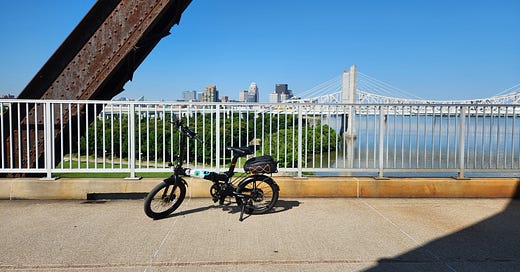In Car-Centric Louisville, E-Bikes Give you a new Kind of Freedom
My experience being an e-bike commuter over the past year
Last summer, I spent around 3,000 dollars to fix up my car after some unexpected issues. This is over 10% of my post-tax income and left me pretty pissed off. My fiance and I eventually decided to sell one of our cars in order to lower transportation costs, and something needed to fill that gap. With TARC facing service reductions, some form of micromobility was the best option for filling the void.
I ended up getting a class 2 foldable e-bike (class 2 meaning it has a max speed of 20 miles per hour), a Qualisports Dolphin. At first I was mildly terrified to ride it, bike infrastructure in Louisville is sub-par by most standards. PeopleForBikes gave us a 2024 bike score of 9/100, and there are no protected bike lanes near my apartment. After my first ride, though, it was obvious riding an e-bike is a bit different than a normal bike in (mostly good) ways if you are just a commuter. After 600 miles of commuting by e-bike over the past year, I thought I would summarize the benefits and downsides of using one in Louisville.
Most e-bikes you see on the road are class 2 or 3, which are able to go up to the standard car speed on neighborhood streets. This means, as the cyclist, you are getting passed less often which means a significant conflict point with cars is taken away. This applies most of the time in Louisville. While many roads in Louisville have 25mph speed limits, wide one-way streets often have cars going 35mph+ in residential areas. This speed also is not accounted for by many drivers, I have had my fair share of close calls with drivers pulling into a parking lot across a bike lane extremely close to me because they think I am going the speed of a standard bike.
While the electric aspect of the bike has allowed me to interface easier with Louisville’s infrastructure, it is still very obvious how the city is not designed for cyclists when I am using it. On a normal journey, you are lucky if 20% of your route has bike lanes, and it is likely that 0% of those lanes are protected or buffered. If you want to go somewhere outside of 264, you are just screwed. TARC’s service is also shoddy outside of 264 since it is so sprawled out, so driving is likely the only option.
Some cyclists will consider riding an e-bike as “cheating”. In that case, I am a proud cheater. A significant barrier to people using micromobility options is the effort that is sometimes required. E-bikes cut out a lot of effort. This may make it seem like you are less active, but it has been shown that e-bike users tend to go further distances, getting a good amount of exercise. This also means that when you show up to work on your bike on a nice 95 degree day, you are not drenched in sweat.
Maintenance and other regular costs on an e-bike are way more manageable than even the most reliable car. If you get insurance, that is likely less than 200 bucks a year. The most expensive part on an e-bike that can break is the battery, which rarely costs more than 1000 dollars (and that's only on the most expensive bikes, mine is closer to $500). So far I have only had a single maintenance issue, and it is specific to my bike: the spring in the throttle likes to pop out when you fold the bike. This wouldn’t be a big deal to most people, but I discovered this when the throttle did not pop back up when I was trying to brake before an intersection.
The most significant downside of an e-bike (or most micromobility options) are the effects of weather. Many e-bikes are rain-safe now, but the manufacturers use that term pretty liberally. Using them in snow can also be dangerous, especially without switching out the tires. This means rain or snow will often put you on the bus or in a car, which is fine for me, but you may live somewhere with unreliable TARC service or do not have a car.
Outside of personal benefits, it is worth mentioning the societal benefits even one e-bike can bring. 600 miles of car commuting produces around 500 pounds of carbon emissions, 600 miles of e-bike commuting produces a whopping… 10 pounds of carbon. Now imagine that extrapolated across thousands of people around Jefferson County. That would be potentially hundreds of thousands of pounds of emissions out of our air, hundreds of thousands of pounds of emissions not being breathed in by you, your kids, or anyone important to you.
Despite some downsides, my overall experience with the e-bike has been great. It has allowed for easy, on-demand, and cheap transit across the urban core of Louisville. While I am pleased with it, I am also disappointed how a more expensive e-bike is required to conveniently traverse the city without a car.
These experiences have left me with a question, though. If using an e-bike is so great, why do they seem so uncommon in Louisville? Regardless of the easier usage, lack of infrastructure still plays a role. We also do not have an e-bike rebate program like many cities are adopting. This can be critical as reliable e-bikes are still moderately expensive. Atlanta was the most recent to adopt one, resulting in 1% of the entire city applying for a rebate within a few days. The lack of widespread adoption of e-bikes and most micromobility comes down to lack of city support in some form. It is simply easier in a lot of ways to use a car, the city is designed with the car-user in mind before anyone else.





